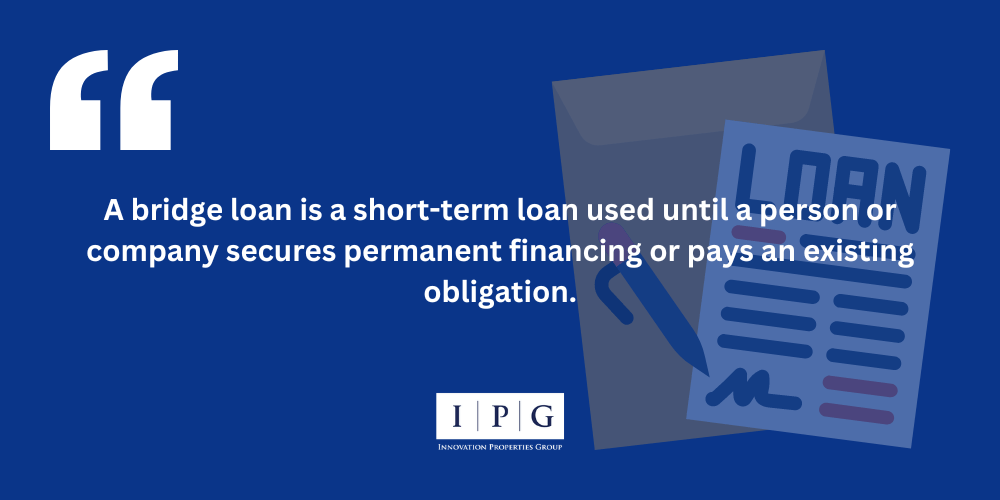What Is A Bridge Loan in Commercial Real Estate?
A bridge loan in commercial real estate is a short-term financing option used by investors and developers to cover immediate expenses until permanent financing can be secured or an existing obligation is removed. These loans are typically used to purchase or renovate properties quickly when timing is crucial and traditional financing options might be too slow or unavailable.
Bridge loans are known for their quick approval and funding processes, but they also come with higher interest rates and shorter repayment terms, usually ranging from a few months to a few years. The loan is often secured by the property itself and may require additional collateral.
The main advantage of a bridge loan is its ability to help buyers compete for properties by providing immediate liquidity. This is particularly useful in competitive real estate markets or when a property requires swift action to capitalize on its potential. After improving the property or stabilizing its income streams, borrowers typically seek to refinance the bridge loan with a more conventional, long-term financial solution.
How Does a Bridge Loan Work?
A bridge loan works as a short-term financing solution, providing quick funds for real estate transactions until longer-term financing can be arranged. Here’s a step-by-step breakdown of how bridge loans operate in real estate:
- Application and Approval: Borrowers apply for a bridge loan typically when they need to act quickly on a real estate opportunity. Since these loans are short-term, the approval process is usually faster compared to conventional loans. Lenders focus on the value of the property and the borrower’s plan for it, rather than the borrower’s creditworthiness alone.
- Terms and Funding: Bridge loans have shorter terms, often between 6 months to 3 years, and they come with higher interest rates due to the increased risk assumed by the lender. Once approved, funding is provided swiftly which allows the borrower to proceed with purchasing or investing in the property.
- Securing the Loan: The loan is typically secured by the property itself. In some cases, lenders might require additional collateral depending on the perceived risk or the borrower’s financial situation.
- Use of Funds: The funds from a bridge loan can be used for a variety of purposes in real estate, such as buying a new property before selling an existing one, completing renovations to increase a property’s value, or stabilizing occupancy to make a property more appealing for long-term financing.
- Repayment: The borrower usually pays off the bridge loan in one of three ways:
- Sale of the Property: The borrower sells the original property and uses the proceeds to pay off the loan.
- Refinancing: Once the property is improved or fully leased, the borrower might secure a more traditional, long-term loan with lower interest rates and use the proceeds to pay off the bridge loan.
- Cash Flow: Depending on the investment, the income generated from the property (like rental income) can also be used to repay the loan.
Bridge loans are particularly useful in competitive real estate markets or when a property requires immediate action to prevent losing an opportunity. However, due to their costs and risks, they should be carefully considered within the broader strategy of property investment.
Bridge Loans vs. Traditional Loans
Bridge loans and traditional loans serve different purposes in real estate financing and come with distinct terms and conditions. Here’s how they compare:
Bridge Loans
- Purpose: Bridge loans are intended to provide quick, short-term funding for real estate transactions. They are typically used when immediate cash is needed, such as buying a new property before selling an existing one, completing quick renovations, or stabilizing occupancy to secure longer-term financing.
- Duration: These loans are short-term, usually lasting from a few months up to three years. The short duration reflects the urgent nature of the funding need and the expectation of a quick turnaround either through sale, refinancing, or improved cash flow from the property.
- Approval Speed: Approval for bridge loans is generally faster than traditional loans. Lenders focus more on the potential value of the property and the exit strategy rather than the borrower’s full financial profile.
- Interest Rates: Bridge loans have higher interest rates compared to traditional loans. The rates reflect the higher risk taken by lenders and the short-term nature of the loan.
- Collateral: The loan is usually secured by the real estate property itself, and sometimes additional collateral may be required.
- Repayment: Repayment typically happens in a lump sum at the end of the term, often from the proceeds of selling the property, refinancing, or income generated from the property’s use.
Traditional Loans
- Purpose: Traditional loans are used for a wide range of purposes but in real estate, they are often used for purchasing or long-term financing of properties.
- Duration: These loans are long-term, usually ranging from 15 to 30 years. This longer duration aligns with the extended period over which the borrower repays the loan, making it suitable for stable, long-term investment strategies.
- Approval Speed: The approval process for traditional loans is more thorough, requiring a detailed check of the borrower’s credit history, income, debt-to-income ratio, and other financial indicators. This process is usually slower compared to bridge loans.
- Interest Rates: Interest rates for traditional loans are generally lower than for bridge loans. The lower rates reflect the reduced risk associated with longer, more stable repayment periods and the thorough vetting process.
- Collateral: Similar to bridge loans, traditional loans are secured by the property. However, the terms may be less stringent given the longer relationship and more extensive borrower vetting.
- Repayment: Repayment of traditional loans is typically done through monthly installments over the life of the loan. These payments usually include both principal and interest components.
Bridging Finance Advantages
Bridging finance, or bridge loans, offers several advantages, particularly in real estate transactions where speed and flexibility are crucial. Here are some key benefits:
- Speed: One of the primary advantages of bridging finance is the rapid access to funds. Bridge loans can often be arranged within a few days to weeks, unlike traditional loans which can take several months to secure. This speed can be critical in competitive real estate markets where quick actions are necessary to secure a property.
- Flexibility: Bridge loans offer more flexibility in terms of repayment and usage. Borrowers can use the funds from bridge loans for a variety of purposes, including property acquisition, construction, renovation, or to resolve urgent cash flow needs. The repayment terms are also often negotiable and can be structured to fit the borrower’s short-term financial strategy.
- No Prepayment Penalties: Most bridge loans do not have prepayment penalties. This feature is beneficial if the borrower manages to secure long-term financing or sells the property quicker than anticipated and wishes to pay off the bridge loan early.
- Solving Timing Issues: Bridging finance helps to solve timing discrepancies between selling an existing property and buying a new one. This can be crucial for buyers who need to act quickly to purchase a new property but have not yet sold their existing property.
- Improvement of Property Value: For properties that need renovation or development before sale or permanent financing, bridge loans can provide the capital needed for such improvements. This can significantly increase the property value for a sale or refinancing at more favorable terms.
- Easier to Obtain: Because bridge loans are secured by real estate, they are generally easier to obtain for borrowers who may not qualify for traditional loans due to credit issues or other financial complexities. Lenders are more focused on the value of the property and the feasibility of the exit strategy rather than solely on the borrower’s creditworthiness.
- Bridging the Gap in Financing: Bridging finance provides necessary capital when traditional funding sources are unavailable or insufficient. It acts as a stopgap to ensure that investment opportunities are not missed.
- Potential for High Loan-to-Value (LTV): Some lenders offer high LTV ratios for bridge loans, sometimes up to 70-80% of the property value. This can be particularly useful in high-stake transactions where significant amounts of capital are required quickly.
These advantages make bridging finance an attractive option for real estate investors, developers, and sometimes homeowners who need immediate funding to bridge gaps in their capital requirements or to leverage time-sensitive opportunities.
Potential Disadvantages of Bridge Loans
While bridge loans offer several benefits, particularly in terms of speed and flexibility, they also come with potential disadvantages that borrowers should consider:
- Higher Interest Rates: Bridge loans typically have higher interest rates compared to traditional, long-term loans. The increased rates compensate lenders for the higher risk associated with shorter loan terms and quicker funding processes.
- Short Repayment Period: Bridge loans are short-term financing solutions, usually requiring repayment within 6 months to 3 years. This short timeframe can put pressure on borrowers to quickly find permanent financing or sell the property to avoid defaulting.
- Additional Fees: Borrowers may encounter various additional costs when securing a bridge loan, including loan origination fees, administration fees, and appraisal fees. These can add up and increase the overall cost of borrowing.
- Risk of Foreclosure: Since bridge loans are secured by property, failing to repay the loan can lead to foreclosure. This risk is significant, particularly if the borrower’s exit strategy (such as selling the property or obtaining long-term financing) fails.
- Dependence on Property Sale or Refinancing: Bridge loans typically rely on the borrower being able to sell the property or secure refinancing to repay the loan. If the real estate market weakens or refinancing options dry up, borrowers may find themselves unable to meet loan obligations.
- Complexity and Risk: The terms and conditions of bridge loans can be complex, and the stakes are high due to the amounts of money involved and the short turnaround times. Misjudging the market or the value of the property can lead to financial losses.
- Equity Requirement: Borrowers often need to have significant equity in their existing property to qualify for a bridge loan, which may not be feasible for everyone.
- Pressure and Stress: The need to secure longer-term financing or sell property under tight deadlines can create stress and lead to rushed decisions, potentially resulting in less favorable outcomes.
Given these potential disadvantages, it’s important for borrowers to carefully assess their financial situation, risk tolerance, and market conditions before proceeding with a bridge loan. It’s often advisable to consult with financial advisors or mortgage professionals to fully understand the implications and strategize appropriately.
For expert guidance on all your commercial real estate needs, get in touch with our professionals today!

















